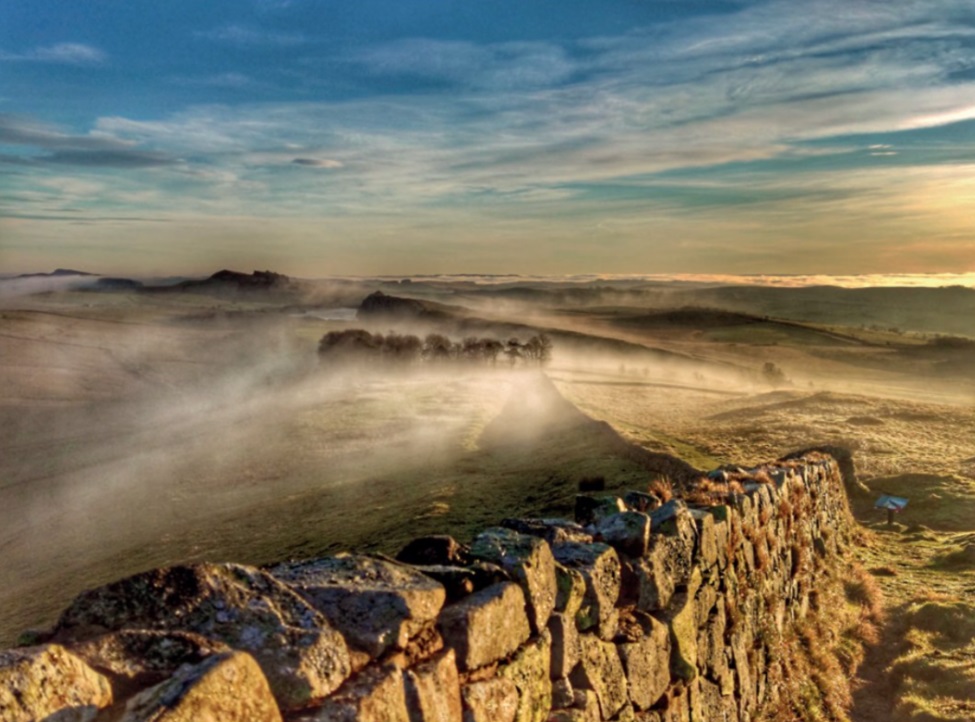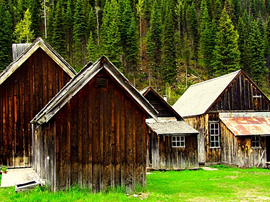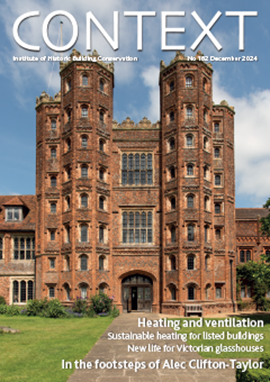Hadrian's Wall Path and the national trails
Winding through, and sometimes over, listed buildings, archaeological sites, world heritage sites and scheduled monuments, the trails are heritage assets in their own right.

|
| January sunshine and mist at the wall (Photo: Hadrian’s Wall Path). |
Our national trails are a special shared asset, golden threads that connect us with national parks and national landscapes, link town to countryside and offer everyone a chance to connect to nature, to each other and to ourselves. The 20 national trails in England, Scotland and Wales, covering over 6,000 miles, are visited by over 83 million people a year. The oldest is the Pennine Way, completed in 1965, and the newest the King Charles III England Coast Path, due for completion this year.
What makes national trails different from other footpaths or bridleways is their designation. Each route is established and approved by government, in England and Wales through the National Park and Access to the Countryside Act 1949, the same legislation as our national parks and national landscapes, (previously known as areas of outstanding natural beauty), and in Scotland through the Countryside (Scotland) Act 1967. The recognition of the need to protect special outdoor spaces at that time is an interesting one. In 1948, the Labour Government led by Clement Attlee had created the National Health Service to make healthcare accessible for all. In debates in Parliament for the 1949 Act, there were discussions about the need to create a complementary ‘Natural Health Service’.
National Trails UK, a new organisation, was created to provide a collective voice for the national trails so that the multiple benefits of these trails can be properly realised and accessible to all. We are the independent champion of the UK’s designated national trails; we are the only place where all the national trails in England, Scotland and Wales come together to share best practice, develop opportunities and speak with a single voice. We prioritise collaboration and co-creation to make sure that we are learning from the experience of our national trails and partners to deliver impactful projects which do something new rather than repeat existing work. Part of the wider family of protected landscapes, we work closely with the UK’s national landscapes and national parks as part of the newly formed Protected Landscape Partnership, as well as other environment and heritage groups.
In England and Wales, each national trail is managed by a national trail officer. They coordinate and carry out the maintenance and repair of the trail, sometimes working with national trail rangers or with volunteer wardens. National trail officers receive some funding from Natural England or Natural Resources Wales and match-fundraise the rest through contributions from local highways authorities, other national trails partners or other projects. In Scotland, the national trails are managed by the national parks and local authorities that they run through.
The national trails offer a great deal to the natural environment as corridors for people and nature. Projects run on the trails help to combat climate change and reverse biodiversity decline. They are also central to our shared cultural heritage. They wind through, and sometimes over, listed buildings, archaeological sites, world heritage sites and scheduled monuments. The trails are notable heritage assets in their own right, telling us about how people have moved through our country over the ages. And people get a wealth of mental and physical health benefits from being in nature and using the trails.
A prime example of the balance of heritage, people, nature and access is Hadrian’s Wall Path. This 135-kilometre national trail follows the line of Hadrian’s Wall from Wallsend, Newcastle-upon-Tyne, in the northeast to Bowness-on-Solway on the west coast. Maintaining the national trail here means ensuring that its physical fabric and its associated archaeology, which is the primary gateway for visitors to the Hadrian’s Wall World Heritage Site, is managed sustainably.
When Hadrian’s Wall Path was being developed over 23 years ago, the idea was to create a green sward over the majority of the trail to protect the underlying archaeology from users while enabling access to the landscape. A managed green, grassy trail is wearable and sustainable and it suits the setting of the world heritage site.
Much of the work on the trail involves repairs to make a smooth, even surface sympathetic to the setting and ensuring that there is a clear path through the landscape, effectively managing the flow of people. A large amount of the sustainable management of the trail can be done in usual daily maintenance. Gary Pickles, the trail ranger, monitors sections of the path to make sure that the walking surface is fit for purpose and remains in the right place. This includes regular mowing and vegetation management and projects to drain muddy areas. Work such as mowing can have a large impact on the maintenance of the monument. In some grassy sections, Pickles mows the path in such a way that the grass clippings fall on its outward sides, helping to naturally delineate the course of the trail and discourage people from areas that might impact on the monument or other protected areas.
Those working on Hadrian’s Wall Path have a generic consent, which enables them to replace trail furniture such as stiles, gates and signs when they break on a like-for-like basis. If larger works are needed that might impact the monument, such as new structures or digging in new sites in the world heritage site, additional consent has to be sought from Historic England.
As quite a bit of maintenance work requires earth to fill holes and worn away sections, the no-digging rule means that Pickles and the team work with what they have around them. While they cannot dig, moles can, and earth from mole hills can be repurposed to fill in sections of trail. This activity is all covered by the generic consent. Adding some grass seed and temporary protection by rubber matting (anything permanent would be an addition to the monument and so require permission) ensures that the soil soon beds into the site and the green sward is maintained.
In other areas, more work might be needed, so additional permissions are sought. Slopes can present an issue, as people like to dig their heels in to get purchase when they go down which damages the trail surface. In many cases, soil from mole hills can again be used to repair the surface. However, rather than removing the rubber membrane used to protect the new patches of soil while the grass grows back, leaving it in provides a stronger surface for people to go up and down and should make the trail more sustainable as it protects the trail surface for longer. In these cases, permission is sought from Historic England for the ‘addition’ to the monument and, if given, the membrane is left in place. Once the grass has grown over the matting, there is very little visible sign of this change and the setting of the trail and the world heritage site is preserved.
There are times when there is a need for a longer-term individual project which cannot be done through daily maintenance. At Cat Stairs, a steep climb near Highshield Crags, a significant problem had developed due to increased accumulated water around a kissing gate and landing, due to increased use and the current drain not being sufficient to allow water to move down the hill. The mud was on top of the aggregate which formed the original path, so Gary Pickles suggested works that would place the new surface on top of the existing structure built in a way that would naturally shed water away from the kissing gate. Once permission was given by Historic England, the works allowed for flagstones and steps to be put in on one side to complement the setting while capping off the drain. On the other, 20mm-to-dust aggregate was laid on top of the existing path to resurface it.
There is a symbiotic relationship between our natural and built heritage. The more work that is done with that in mind, the more people will experience the benefits of using the national trails and interacting with the heritage they see along the way. National Trails UK hopes to champion the sustainable management of the national trails for people, nature and heritage.
This article originally appeared in the Institute of Historic Building Conservation’s (IHBC’s) Context 179, published in March 2024. It was written by Polly Martin, chief executive officer at National Trails UK.
--Institute of Historic Building Conservation
Related articles on Designing Buildings
IHBC NewsBlog
SAVE celebrates 50 years of campaigning 1975-2025
SAVE Britain’s Heritage has announced events across the country to celebrate bringing new life to remarkable buildings.
IHBC Annual School 2025 - Shrewsbury 12-14 June
Themed Heritage in Context – Value: Plan: Change, join in-person or online.
200th Anniversary Celebration of the Modern Railway Planned
The Stockton & Darlington Railway opened on September 27, 1825.
Competence Framework Launched for Sustainability in the Built Environment
The Construction Industry Council (CIC) and the Edge have jointly published the framework.
Historic England Launches Wellbeing Strategy for Heritage
Whether through visiting, volunteering, learning or creative practice, engaging with heritage can strengthen confidence, resilience, hope and social connections.
National Trust for Canada’s Review of 2024
Great Saves & Worst Losses Highlighted
IHBC's SelfStarter Website Undergoes Refresh
New updates and resources for emerging conservation professionals.
‘Behind the Scenes’ podcast on St. Pauls Cathedral Published
Experience the inside track on one of the world’s best known places of worship and visitor attractions.
National Audit Office (NAO) says Government building maintenance backlog is at least £49 billion
The public spending watchdog will need to consider the best way to manage its assets to bring property condition to a satisfactory level.
IHBC Publishes C182 focused on Heating and Ventilation
The latest issue of Context explores sustainable heating for listed buildings and more.
















